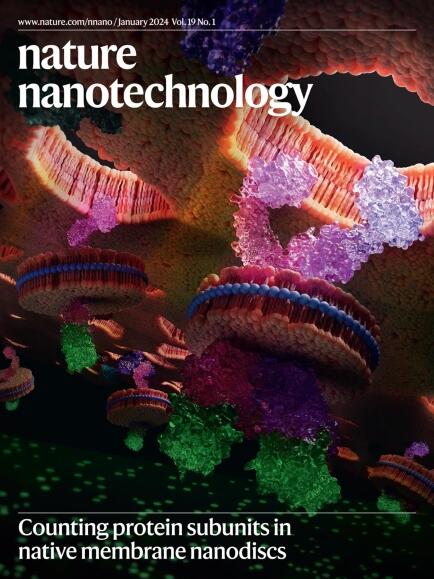Full-length protein classification via cysteine fingerprinting in solid-state nanopores.
IF 34.9
1区 材料科学
Q1 MATERIALS SCIENCE, MULTIDISCIPLINARY
引用次数: 0
Abstract
Recent advances in single-molecule technologies are transforming the field of protein analysis. Solid-state nanopores provide an effective method to linearize and thread full-length proteins in a single file. However, slowing their rapid translocation remains a challenge for accurate, time-resolved ion-current-based fingerprinting. In this work, we present a click-chemistry-based strategy for covalently attaching short oligonucleotides to cysteine residues on denatured proteins across a broad range of molecular weights. The negatively charged oligonucleotides increase the capture rate by a factor of ten compared with native proteins and induce a distinct 'stick-slip' motion that slows protein passage through the nanopore by more than 20-fold. These oligonucleotide tags also produce characteristic, time-resolved ion current pulses that serve as unique protein-specific signatures. To uncover the physical mechanism responsible for the protein translocation dynamics, we model our system using all-atom molecular dynamics and finite element simulations. By leveraging a supervised machine learning classifier, we demonstrate that a small number of translocation events is sufficient to identify individual proteins, achieving near-perfect classification accuracy. To demonstrate the robustness of the method, we successfully distinguish between VEGF-A isoforms (VEGF-165 and VEGF-121), which are relevant to cancer diagnostics, within a mixed protein sample. Our nanopore-based fingerprinting technique eliminates the need for affinity reagents, such as protein-specific antibodies, or motor proteins, offering a rapid, direct and cost-effective approach for single-molecule protein identification and classification.半胱氨酸指纹在固态纳米孔中的全长蛋白质分类。
单分子技术的最新进展正在改变蛋白质分析领域。固体纳米孔提供了一种有效的方法来线性化和线程全长蛋白质在单一文件。然而,对于精确的、时间分辨的基于离子电流的指纹识别来说,减缓它们的快速转移仍然是一个挑战。在这项工作中,我们提出了一种基于点击化学的策略,用于在广泛的分子量范围内将短寡核苷酸共价连接到变性蛋白质的半胱氨酸残基上。与天然蛋白质相比,带负电荷的寡核苷酸将捕获率提高了十倍,并诱导了一种明显的“粘滑”运动,使蛋白质通过纳米孔的速度减慢了20倍以上。这些寡核苷酸标签也产生特征,时间分辨离子电流脉冲,作为独特的蛋白质特异性签名。为了揭示蛋白质易位动力学的物理机制,我们使用全原子分子动力学和有限元模拟来模拟我们的系统。通过利用有监督的机器学习分类器,我们证明了少量的易位事件足以识别单个蛋白质,实现了近乎完美的分类精度。为了证明该方法的稳健性,我们在混合蛋白样品中成功区分了与癌症诊断相关的VEGF-A亚型(VEGF-165和VEGF-121)。我们基于纳米孔的指纹识别技术消除了对亲和试剂的需求,如蛋白质特异性抗体或运动蛋白,为单分子蛋白质鉴定和分类提供了快速,直接和经济有效的方法。
本文章由计算机程序翻译,如有差异,请以英文原文为准。
求助全文
约1分钟内获得全文
求助全文
来源期刊

Nature nanotechnology
工程技术-材料科学:综合
CiteScore
59.70
自引率
0.80%
发文量
196
审稿时长
4-8 weeks
期刊介绍:
Nature Nanotechnology is a prestigious journal that publishes high-quality papers in various areas of nanoscience and nanotechnology. The journal focuses on the design, characterization, and production of structures, devices, and systems that manipulate and control materials at atomic, molecular, and macromolecular scales. It encompasses both bottom-up and top-down approaches, as well as their combinations.
Furthermore, Nature Nanotechnology fosters the exchange of ideas among researchers from diverse disciplines such as chemistry, physics, material science, biomedical research, engineering, and more. It promotes collaboration at the forefront of this multidisciplinary field. The journal covers a wide range of topics, from fundamental research in physics, chemistry, and biology, including computational work and simulations, to the development of innovative devices and technologies for various industrial sectors such as information technology, medicine, manufacturing, high-performance materials, energy, and environmental technologies. It includes coverage of organic, inorganic, and hybrid materials.
 求助内容:
求助内容: 应助结果提醒方式:
应助结果提醒方式:


